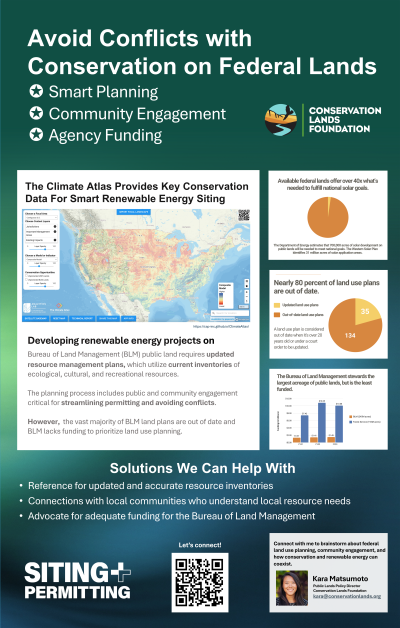Community Engagement Tips to Avoid Conflicts With Conservation Planning on Federal Public Lands
Tuesday, April 15, 2025
5:00 PM - 6:00 PM PT
Location: Regency Ballroom


Kara Matsumoto, MS (she/her/hers)
Public Lands Policy Director
Conservation Lands Foundation
Durango, Colorado
Poster Presenter(s)
Encompassing 245 million acres, Bureau of Land Management (BLM) landscapes are playing a critical role in the country’s transition to renewable energy. The deployment of renewable energy, however, often conflicts with conservation goals due to BLM’s outdated land use plans. Fortunately, it doesn’t have to.
We will explore how creative community engagement can help navigate and find solutions for potential conflicts. We will evaluate the regulatory and policy context of conservation and energy development on public lands, including the newly finalized Public Lands Rule, and how these tools can help achieve the energy transition and conservation goals at the same time.
While BLM took a good first step in streamlining solar development on public lands through its newly updated Western Solar Plan, there remain conflicts with conservation priorities on the ground. Many land use plans have not been updated in decades, resulting in failures to account for new data and resource inventories. This outdated information creates significant challenges for renewable energy developers as proposals may inadvertently conflict with ecological or cultural values, potentially causing permitting delays.
We’ll share: how the conservation community evaluates and tracks proposed energy projects, using the Conservation Lands Foundation’s Climate Atlas web tool to visualize impacts on the ground; how engaging with communities and grassroots organizations–who best know the local resource values–can help bridge gaps resulting from outdated management plans; and how the new regulatory context created by the Public Lands Rule creates a modern and responsible roadmap for balancing renewable energy development and conservation through land use planning.
We will explore how creative community engagement can help navigate and find solutions for potential conflicts. We will evaluate the regulatory and policy context of conservation and energy development on public lands, including the newly finalized Public Lands Rule, and how these tools can help achieve the energy transition and conservation goals at the same time.
While BLM took a good first step in streamlining solar development on public lands through its newly updated Western Solar Plan, there remain conflicts with conservation priorities on the ground. Many land use plans have not been updated in decades, resulting in failures to account for new data and resource inventories. This outdated information creates significant challenges for renewable energy developers as proposals may inadvertently conflict with ecological or cultural values, potentially causing permitting delays.
We’ll share: how the conservation community evaluates and tracks proposed energy projects, using the Conservation Lands Foundation’s Climate Atlas web tool to visualize impacts on the ground; how engaging with communities and grassroots organizations–who best know the local resource values–can help bridge gaps resulting from outdated management plans; and how the new regulatory context created by the Public Lands Rule creates a modern and responsible roadmap for balancing renewable energy development and conservation through land use planning.
